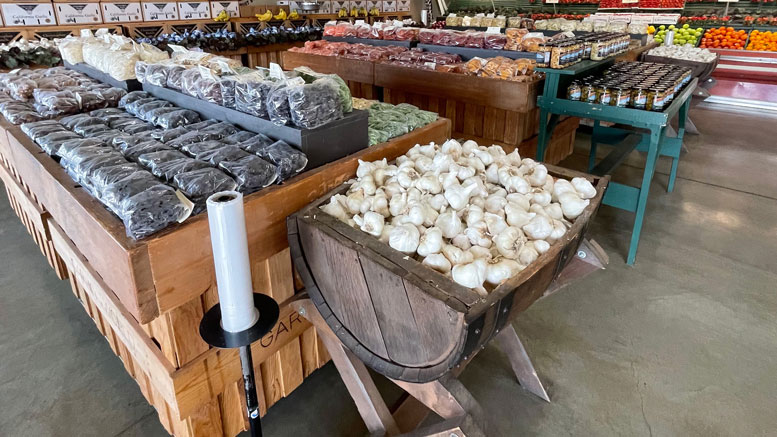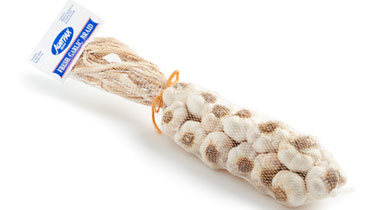Six Strategies For Successful Garlic Sales
August 16, 2022 | 9 min to read
Increasing consumer interest in garlic has shifted it from a niche to a staple in grocery lists, with U.S. consumption reaching two pounds per capita. Experts highlight that the pandemic accelerated demand as home cooking surged. Retailers can increase sales by enhancing garlic displays, ensuring cleanliness, offering variety, and including fresh value-added products. Promotions during fall and holiday seasons, paired with affordable pricing strategies, support garlic's reputation as a healthy and flavorful cooking essential.

By paying a little extra attention to garlic, produce departments can move more product.
Originally printed in the July 2022 issue of Produce Business.
Decades ago, garlic was not a regular item on shoppers’ grocery lists. “Garlic used to be a cultural thing, but now it’s not,” says Mark Cotê, regional produce supervisor at Redner’s Markets in Reading, PA, with 44 stores. “Now everybody is cooking with garlic.”
U.S. garlic consumption has reached 2 pounds per capita and continues to steadily increase, according to U.S. Department of Agriculture (USDA) statistics.
“Garlic has continued to increase in demand in the produce department,” says Kenneth Christopher, executive vice president at Christopher Ranch in Gilroy, CA. “Since the advent of the pandemic, consumers are increasingly turning to garlic as a healthy option for flavoring their food. Even with a relative state of ‘normalcy’ in relation to the start of lockdowns, demand for garlic continues to be historically high.”
Sales of fresh garlic got a bump in demand during the COVID-19 pandemic, because people were cooking at home and eating healthier, explains Jim Provost, president of I Love Produce in West Grove, PA. “Through the purchase of home delivery meal kits, consumers were introduced to cooking with garlic, as well as ginger and shallots, for the first time,” he says.
Food King in Lubbock, TX, one outlet of a 160-store chain, sells a high volume of garlic. “Our demographic includes Hispanic and Indian shoppers and they use a lot of garlic,” says Bert Ramirez, produce manager. “Our shoppers will buy anywhere from three to 10 heads at a time. The majority of our customers use garlic because it’s healthy and their cuisine calls for it. Between bulk and sleeve garlic, I bring in about four cases a week. That’s a lot of garlic.”
Garlic is a staple, constant item and shoppers do seek it out. “Garlic is one of those staple items that just seems to always sell,” says Joey Granata, director of produce at FreshPro Food Distributors in West Caldwell, NJ. “Demand seems to be consistent and steady.”
Another advantage of garlic is its uniqueness. “Garlic is an item that has no other replacement,” says Bruce Klein, director of marketing for Maurice A. Auerbach Inc. in Secaucus, NJ. “It’s essential to so many recipes and you really can’t substitute any other ingredient for it. It’s also healthy so consumers wouldn’t have the need to substitute it. In fact, garlic can be used as a substitute for other higher fat flavorings.”

PHOTO COURTESY MAURICE A. AUERBACH INC.
Year-round supply of garlic from various sources allows buyers to keep shelves stocked. U.S. garlic production is concentrated in California, with smaller acreages in Oregon, Nevada, Washington and New York. The U.S. is also the world’s largest importer of garlic, primarily from China, Argentina and Mexico.
“California garlic starts around June/July and Argentina is available around December,” says Klein. “Mexico supply starts in April/May and then we’re back to California again. We follow the different growing regions of garlic so we can get the freshest garlic to our customers.”
Here are six ways retailers can boost their sales of garlic:
1. Be Intentional With DISPLAYS
Garlic is no longer an afterthought. Stores who put deliberate thought into location and size of the garlic display will see results. “Anecdotally, I have noticed garlic displays have grown in size over the last 20 years,” says Provost. “As a friend used to say, ‘Pile it high, and let it fly’. The growth of the category and the margins enjoyed by the retail sector justify the space.”
Garlic should start with a base display where shoppers can always find it. “Bulk garlic is best sold with the onions and potatoes,” says Food King’s Ramirez. “Customers look for it there, so we want them to always be able to find it. We see good movement in that base display location.”
Stores should also use secondary displays. “Of course, garlic is displayed within your hardware sections, but displaying with the avocados and tomatoes works well too,” says Granata. “And, stores can also tie it in by the seafood departments to capture more sales.”
Christopher suggests displaying fresh garlic in wooden bins, next to the avocados and tomatoes, where garlic’s white color is an excellent tool for color blocking.
2. Ensure It’s Clean & Attractive
Though garlic is not as perishable as other produce items, store personnel should remain diligent in cleaning and rotating the garlic displays. “The most important elements of a good garlic display are having fresh, clean displays and cleaning loose skin off where possible,” says FreshPro’s Granata.
Attractive displays encourage purchase. “Stores must rotate it and make sure it looks good on the shelf,” agrees Auerbach’s Klein. “The consumer might buy two heads if it looks good rather than only one if the display is messy. A clean, attractive display sells more. If you clean up the display and make it look good, the consumer is more apt to purchase more product. You want the product to look as best as possible on the shelf.”
Garlic skins tend to shed, especially as consumers handle them, so cleaning up the loose skins is essential. Departments must manicure garlic, asserts Cotê of Redner’s. “Just like onions, if you see more onion skins than onions, it’s a turn off and the same is true for garlic,” he says.
3. Offer Variety
Increasing demand for garlic has resulted in a host of garlic options at retail, and Ramirez emphasizes it’s important to have a variety of product to hit each consumer need. “It’s about putting together a mix for everyone,” he says. “We do bulk, sleeves, jars and some other value-added presentations. We also offer braids on a seasonal basis — a garlic braid is more of a novelty and a fall item.”
Displaying a variety of garlic options together will help shoppers. “Make a one-stop shop for consumers so they can find their bulk garlic, packaged garlic, jar garlic and other garlic-related products in one area,” says Provost of I Love Produce.
Klein explains some of the variety of garlic presentations and varieties. “We handle bagged garlic, custom packed, from eight ounce to 10 pounds,” he says. “There is also Elephant garlic, which is a close relative of the leek. Elephant garlic is typically sweeter, milder and larger than standard types of garlic. We also sell individually netted head packed garlic. Then there are the garlic braids, which are long-stemmed garlic bulbs woven together into a decorative braid. Other presentations include clam shells.”
A variety of garlic products caters to various consumer niches. “Garlic is a staple, but can also be an impulse item,” says Provost. “Chinese garlic has a price point that will attract budget-conscious consumers, while premium garlic products like Black Garlic, Elephant garlic and Super Colossal Spain and California garlic have a higher end niche.”
Christopher points out the opportunity to promote organic and U.S.-grown. “Garlic is most profitable for retailers when they select organic, fresh garlic bulbs,” he says. “Consumers are willing to pay a premium for organic, American-grown produce. When retailers use clear country of origin labeling that highlights locally grown produce, consumers gravitate to those products.”
Cotê sees organic garlic growing in demand. “Over the last 10 years, we’re selling a lot more organic,” he says. “It really pushes the category and gives it a boost.”
4. Include Fresh Value-Added
At one time, value-added garlic was just jars, but new technology and options take this convenience to a new level. For example, Auerbach offers packaged organic and conventional peeled garlic for retail. “These products offer convenience to the consumer, yet still have a fresh taste,” says Klein. “Shoppers can buy six or eight ounces of peeled garlic and use it as needed. It’s a matter of convenience.”
While processed garlic may have a long shelf life, Christopher comments on how the preservatives in it tend to give the garlic a more citric taste. “For retailers who want to promote true garlic flavors, they should focus on fresh and pre-peeled garlic,” he says. “This garlic has the flavors most consumers are looking for. Processed garlic may be convenient, but it doesn’t offer true garlic flavor.”

PHOTO COURTESY I LOVE PRODUCE
Redner’s includes fresh peeled garlic as an option for its shoppers. “We buy the large four-pound containers of peeled garlic, break them down and repack them into smaller packs,” says Cotê. “It makes a better price-point for our shoppers and better pricing for us.”
Christopher advises stores to showcase peeled and roasted garlic in the refrigerated section of their displays. “It’s important to maintain the cold chain for these products, from production to distribution and to the point of sale,” he says.
Food King offers peeled value-added garlic, but Ramirez says it can be hit or miss due to the price. “Some customers like it, but others would rather buy the bulk and peel it themselves,” he says. “There is a niche demographic for it, so we carry it.”
5. Expand Promotable Periods
Retailers should be aware of the ebb and flow of garlic supply and promotion opportunity. “Garlic is not a big promotable item that will generate lots of sales, but good times to promote include during the Lenten season, in the fall and at Christmas,” says FreshPro’s Granata.
Provost expects good garlic availability from the Northern Hemisphere growing regions. “This means garlic will be promotable from August through December, the peak of the fall cooking and holiday period,” he says. “This year will be a good year to particularly promote garlic for Rosh Hashanah, Yom Kippur, Columbus Day, Halloween, Thanksgiving, Hanukkah and Christmas.”
Though garlic tends to be used more in the colder months when people cook inside, retail can promote in the summer as well, suggests Auerbach’s Klein. “Consumers increasingly use garlic in marinades and barbecues,” he says. “Stores can look to up their promotion and merchandising for the summer grilling season.”
6. Advocate Bang For The Buck
In the tight economy, garlic offers a savory, healthy meal addition for relatively low cost. “Garlic offers the most bang for your buck when it comes to adding additional flavor to just about any dish,” says Christopher. “A couple of cloves of garlic can transform a meal, giving consumers exceptional value.”
Stores can promote various garlic packaging as a good value. “A five-bulb netted garlic has a great price point and value for the consumer,” says Provost. “Shoppers can buy a week to a month’s supply of garlic at an affordable retail price.”
Promoting particular bulk price strategies can also attract cost-conscious shoppers. “Fresh garlic bulbs can be sold at two for $1 to maximize sales,” says Christopher. “Consumers will feel like they’re getting a deal and retailers will enjoy increased throughput.”
Redner’s Cotê points out garlic is relatively inexpensive to begin with. “So, most of the time, the price on bulk garlic is accessible to shoppers,” he says. “Setting up some ads for garlic would also be advantageous.”
7 of 21 article in Produce Business August 2022

